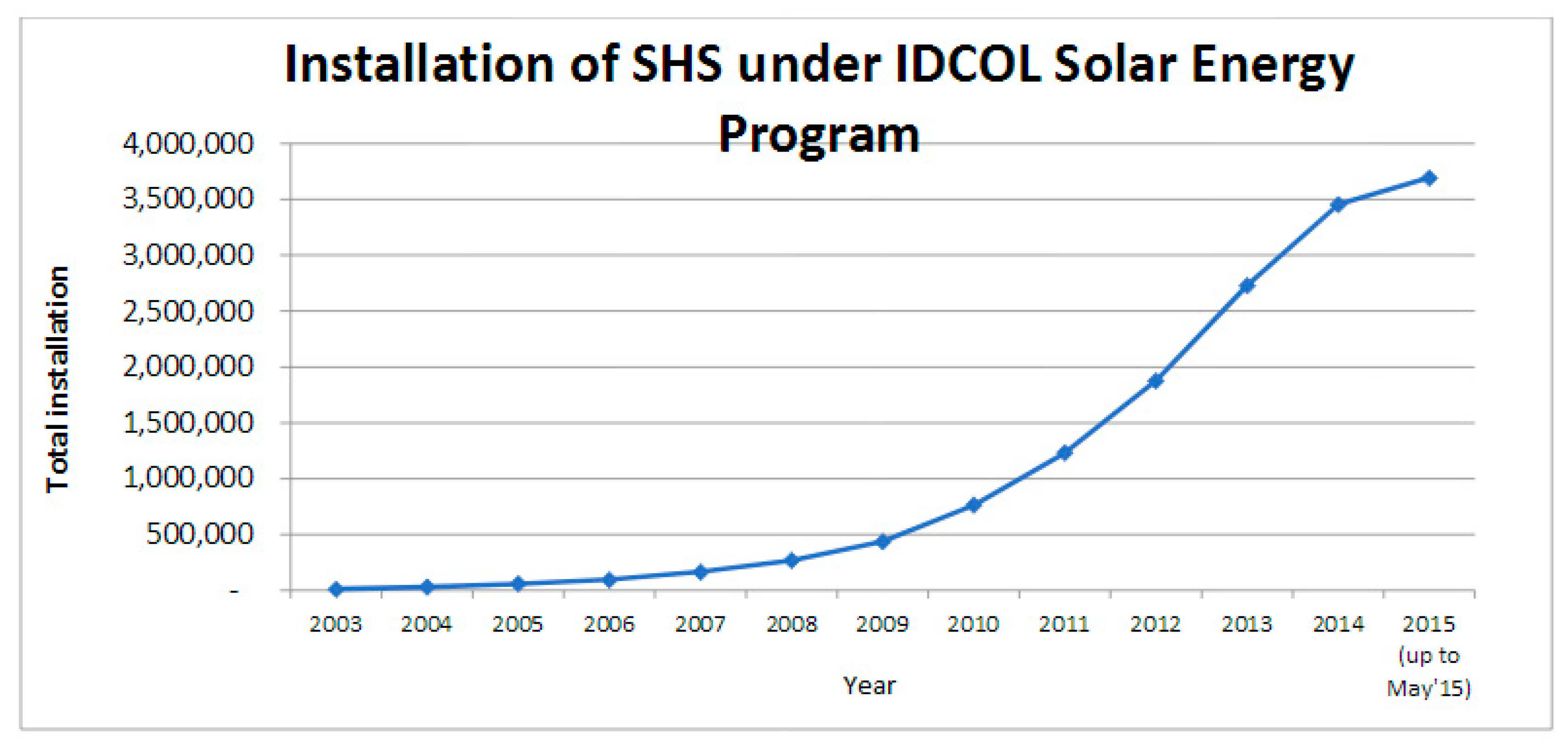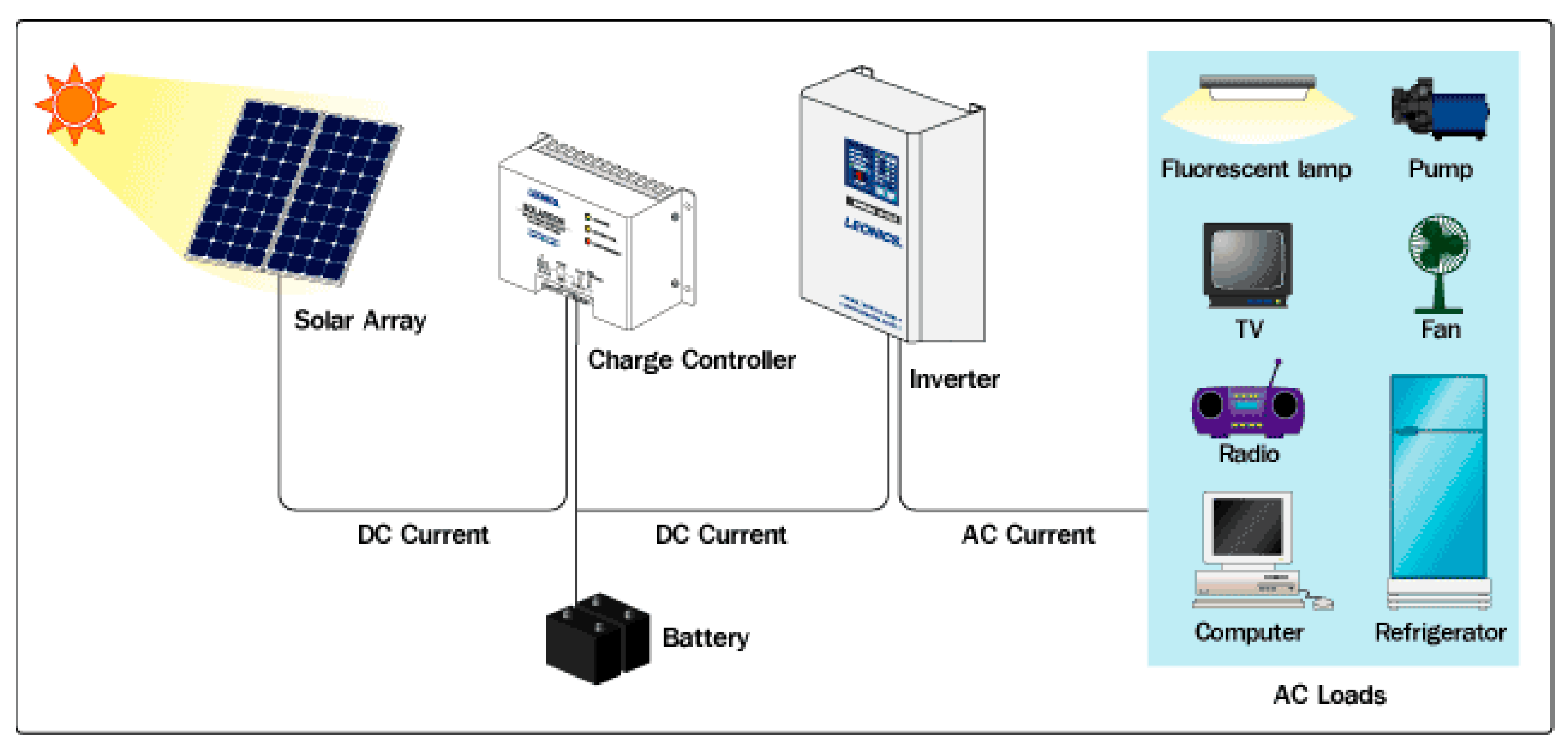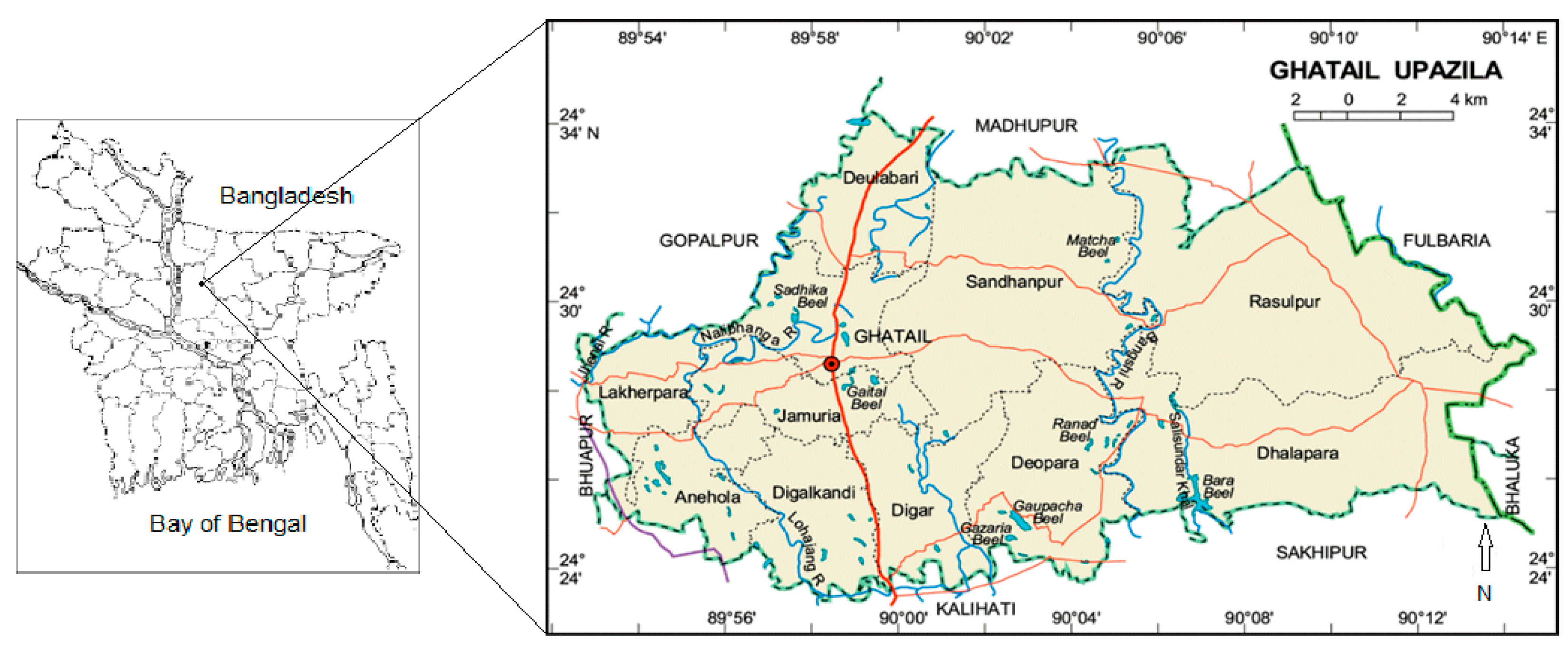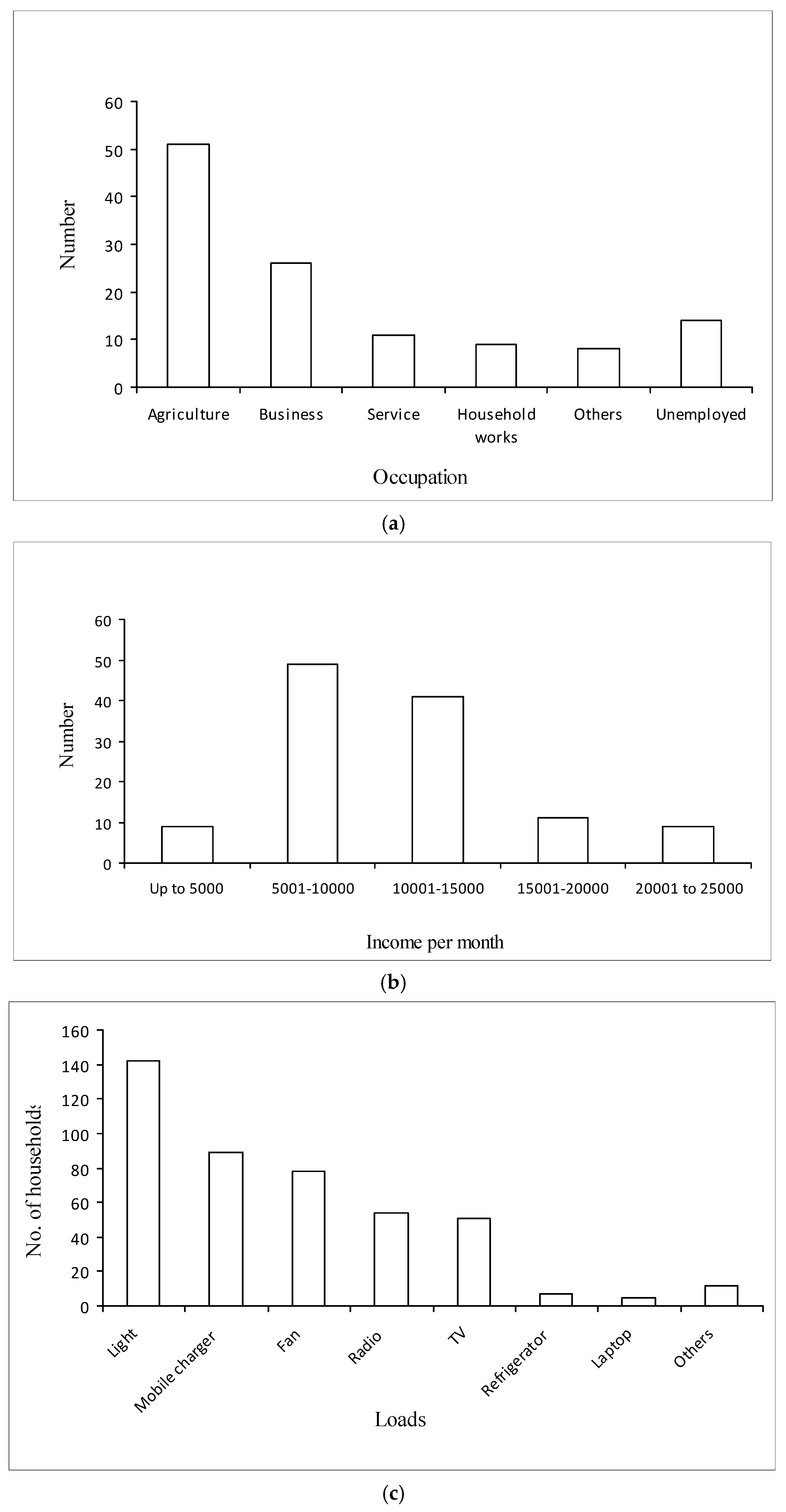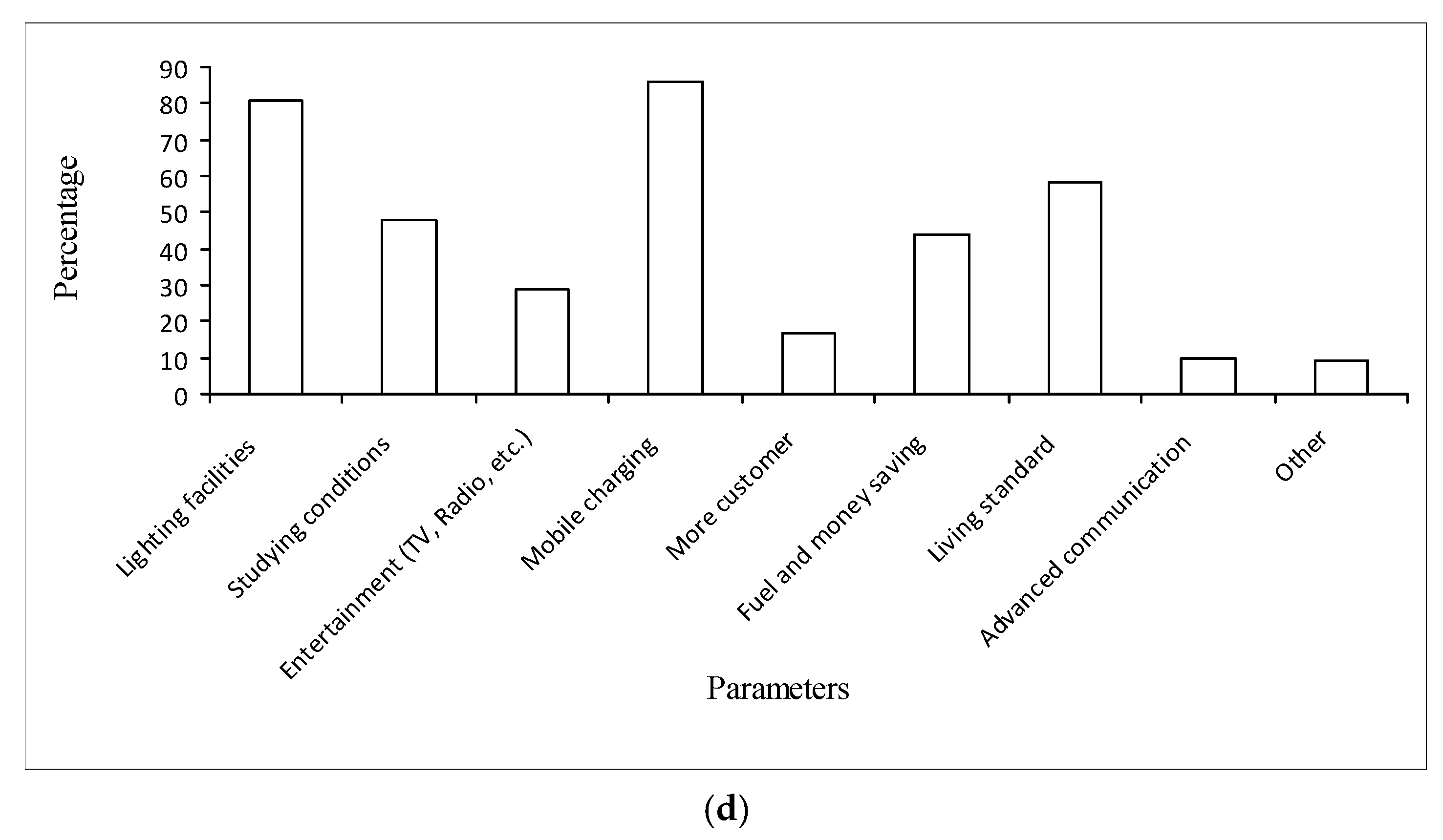1. Introduction
Lack of access to electricity is a major constraint on growth and development in Third World rural areas [
1]. A large number of rural settlements are still without access to electricity, especially in sub-Saharan Africa and developing Asian countries [
2]. Due to high transmission and distribution costs in remote areas, many households are not connected to the national electricity network [
3]. For example, in rural areas of Bangladesh, where more than 70% of the population lives, only 42% have access to the (unreliable) electricity supply [
4].
Global electricity generation depends mainly on depleting fossil fuel sources followed by nuclear, hydro, and other renewable sources (e.g., wind, solar, tidal wave, and geo-thermal energy). Pollution emitted by coal and natural gas plants is linked to several types of health and environmental hazards [
5,
6]. Moreover, CO
2 emissions contribute to global warming and climate change (IPCC). Renewable energy is extremely important to ensure future energy security, stability, and prosperity. In addition, a switch to renewable energy can reduce global warming emissions. Being nearly inexhaustible, solar energy can also help stabilize energy prices, along with providing many other economic benefits [
7]. Solar energy has the greatest potential of any almost-continuous energy source [
8].
Sunlight covers the electromagnetic spectrum ranging from ultraviolet, visible light, and infrared (heat). All may be utilized directly or indirectly through conversion into electricity [
9]. According to the National Renewable Energy Laboratory (NREL), the technical potential of photovoltaic cells and concentrated solar power (CSP) is as much as 200,000 GW in the United States alone; this is enough to generate about 400,000 TWh of energy annually [
8]. Despite high initial investment costs, a solar home system (SHS) is an emerging alternative energy source for many rural areas in the developing world. Simplicity and emission-free conditions are key attractions of SHSs. Moreover, the cost of solar systems has declined significantly, while their efficiency has increased greatly with advances in technology. For example, the total module cost decreased from around
$1.30 per watt in 2011 to around
$0.50 per watt in 2014 (almost 60%) [
10]. Likewise, solar cell efficiency has improved constantly (e.g., from 11.4 to 17% using perovskite [
8]).
Figure 1 shows the worldwide growth of solar systems since 2006. However, in developed countries, almost 100% of the population has access to grid electricity. Large-scale solar energy usage is found mainly in developed countries. In contrast, in the developing world, small-scale (40 to 100 Watt) domestic solar systems are more prominent. About 1.1 billion people, concentrated in Africa and Asia, are known to live without access to electricity [
11].
The SHS program has been very successful (
Figure 2) in Bangladesh, where SHS projects are managed by a government financial institution (Infrastructure Development Company Limited (IDCOL)) [
13]. The Bangladeshi SHS model could be replicated and launched in other parts of the world. This survey study conducted in rural areas of Tangail district focused on the impacts of SHSs on rural population lives in Bangladesh. Mondal and Klein [
14] and Khan and Azad [
15] also conducted their study on SHS social impacts of rural people near Dhaka city in October 2004 to January 2005 and 2013, respectively. However, over the years, the basic conditions of SHS technology (e.g., package price, load demands, socio-economic condition, and awareness) have been changed. Evaluation of the social impacts of SHSs on the lives of rural people who are not connected to electricity grids can be assessed after the installation of the SHSs and may help policymakers create SHS policies to improve the living standards of off-grid rural populations world-wide.
2. Operation Principle of an SHS
Solar panels are made up of many individual solar energy collectors called solar or photovoltaic (PV) cells that convert sunlight energy directly into electricity due to the photovoltaic effect [
17]. Solar cells are usually wafer-based crystalline silicon cells or thin-film cells on cadmium telluride or silicon substrate [
18]. The cells are very thin (about 1/100th of an inch), usually 3 to 4 square inches (around 20 to 25 cm
2), and have a standard lifetime of 20–30 years [
19].
An SHS includes a solar panel, one or more batteries, a charge regulator or controller, an inverter to convert direct current (DC) to alternating current (AC) for grid-compatible AC appliances, cables, and switches for safety (
Figure 3). An SHS usually operates at a rated voltage of 12 V direct current (DC) to provide power for low power DC appliances such as lights, radios, and small TVs for about three to five hours a day [
20]. The PV module is usually placed on the rooftop of a house at an angle to collect maximum sunlight. The battery of the SHS should typically have a storage capacity of 3 days in the event of cloudy days.
3. Site Area and Household Characteristics
This case study was carried out at Ghatail Upazila, which is located in the Tangail district, Bangladesh from April to December, 2014 (
Figure 4). This area was chosen as many parts of this area are not connected to the national grid. The study area selected in this study thus represents ones with true rural characteristics of Bangladesh away from urban facilities. A total of 119 SHS users were surveyed, including household (98 users) and small businesses (21 users), by the face-to-face questioner method. The survey contained both closed-ended questions (i.e., respondents were given a list of predetermined responses from which to choose their answer) and open-ended questions (respondents were asked to answer in their own words). Data were collected on the basis of five-point
Likert scale, ranging from 1 = strongly disagree to 5 = strongly agree. Both the open-ended and close-ended questions were included in the questionnaire. Questionnaire was carefully developed and tested before it was finalized to find out customer satisfaction of the SHS customers. Here Servqual Model is used to assess the gap between the expectations and perceptions of the customers. The data analysis involved quantitative and qualitative methods (numerical and descriptive). Qualitative data were analyzed based on content analysis while quantitative data were analyzed using descriptive and inferential statistics.
Agriculture is the main occupation (42.9% of respondents) in the study area. About 22% of the respondents engaged in some business activities (
Figure 5a). About 49% and 41% of SHS households had monthly incomes of 65 to 130 USD (5001 to 10,000 Bangladeshi Taka (BDT)) and 130 to 190 USD (10,001 to 15,000 BDT), respectively (
Figure 5b). Of the available 30, 40, 50, 60, 75, 80, and 120 Wp SHSs; 40 to 85 Wp SHSs are the most common in rural areas, with the 50 Wp SHS the most common SHS used by households [
23]. Typical operating load of a 50 Wp SHS is 3–5 LED bulbs and a 14′′ or 17′′ black & white TV. There are different credit and pricing options for purchasing SHS unit, e.g., cash, one, two, or three-year installment plans. For example, the cost of a 50 Wp system is around 19,500 or 27,100 BDT (250 or 346 USD) with cash or a three-year microloan facility, respectively [
24]. The SHS cost (250 USD) in Bangladesh represents a large fraction (7.8%) of the purchasing power parity (PPP) GDP per capita (3175 USD) of that country. In contrast, in the USA (PPP GDP per capita 54,000 USD), it is only 0.46% [
25]. The estimated medium income of the villagers is around 1500 USD·year
−1 at the March 2016 exchange rate.
The Infrastructure Development Company Limited (IDCOL) supports the distribution of SHSs in the remote areas where electrification through gird expansion is challenging and costly through 47 Partner Organizations (POs), namely experienced non-governmental organizations (NGOs) such as Grameen Shakti (GS), the Bangladesh Rural Advancement Committee (BRAC), Rural Services Foundation (RSF), and SolarEn [
26]. A number of smaller NGOs and private enterprises also participate in SHS distribution in Bangladesh. However, IDCOL provides refinancing facilities to the POs and channels grants to reduce the cost of the systems to make them more affordable to rural customers. According to the collected data, about 82% households microfinanced their SHS by monthly installments, mostly over a period of 3 years. For a 3-year microloan plan, a minimum 10 to 15% down payment was required and the remaining amount was required to be repaid within (maximum) 36 months at a ~12% (flat rate) service charge per year, equivalent to >20% compound interest per year. This type of policy can also be implemented in other parts of the developing world to enable poor people to have easy SHS access.
5. Impacts of SHSs
An SHS has both direct and indirect impacts on users, with some impacts permanent in nature. Access to SHS electricity enhances the general quality of life of its users. Activities of daily living (ADL) like studying and working under light, watching TV programs, charging electronic devices (e.g., mobile phones, laptop, etc.) are frequently undertaken by people who have an SHS unit in their household, thus promoting household welfare by providing a better quality of life or more productivity.
Figure 5d lists the positive impacts of SHS on quality of life in the studied area.
5.1. Lighting Facilities
Lighting is the most common SHS application, and most SHS packages include LED lights. LED lighting provides a step forward in quality and convenience. Solar lighting allows rural families to extend their workday into the evening hours. Due to extended study and household work hours, convenience, safety, cleanness, and brightness, lighting is considered to be the most important benefit of SHSs. Approximately 64% (
n = 77) of householders responded that lighting was the main purpose they installed an SHS. Poisonings, fires, and explosions are well-documented kerosene hazards [
27]. In contrast to kerosene lamps, solar lights (or lanterns) are free of toxic emissions. Moreover, use of an SHS reduces the time spent maintaining and refueling kerosene lamps. In rural areas, purchasing and transporting kerosene fuel is often both difficult and expensive. Brighter SHS lights are also a vast improvement on the poorer light provided by kerosene lamps. Due to lighting facilities, students had more time to study, and women no longer depended solely on sunlight to complete their household chores. Lighting also benefited other household activities, such as sewing by women, social gatherings after dark, and so on. Solar electricity also helped local enterprises like small shops and village markets to operate during the evening, and relieved their reliance on grid supply, which is very unreliable, especially in rural areas of Bangladesh.
5.2. Information Facilities
Although lighting was the most popular application, access to various entertainment and communication facilities provided a strong SHS incentive. SHS increased the opportunity to access information through watching TV and/or listening to radio broadcast information, and provided better communication opportunities via mobile phones and/or the Internet. Due to the high level of illiteracy prevalent in rural areas, radio and television are the most effective means of reaching rural inhabitants, and thus play an important role in socio-economic development [
28]. The Internet has now made it possible to obtain and share information, e.g., on education and health issues with local and international organizations such as NGOs, farmers’ organizations, and women’s organizations. International development agencies and national development partners are already experimenting with new information technologies and electronic communication networks for rural development. Such information tools can be very influential at spreading important messages about new agricultural production ideas and techniques as well as health, nutrition, family planning, and other social and cultural issues. Besides personal communication, mobile communication has several economic and social benefits; it can enhance entrepreneurship, reduce information asymmetries and market inefficiencies, and facilitate better transport. Access to such facilities can bring about changes in the lifestyle of rural people. Rather than spending time talking to each other (socializing), the participants of our study preferred to watch TV shows to be up-to-date on current national and global affairs. Rural people gathered in tea stalls or shops in the market place to watch a special program, movie, or match together. Enjoying TV entertainment shows helped them to relax after a day’s farming and other activities. Rechargeable lead-acid batteries usually used to power TV sets need to be transported over several kilometers for recharging in many cases. An SHS requires only sunlight and will last up to 20 years with minimal servicing.
5.3. Health and Environment
SHSs can have significant health and environmental benefits in rural areas. Because an SHS has a minimal installed carbon footprint and solar energy is in almost inexhaustible supply in the foreseeable future, SHSs are likely to have more positive environmental impacts than fossil and biomass fuels. An SHS can replace kerosene lamps, which emit substantial amounts of fine particulates, carbon monoxide (CO), nitric oxides (NO
x), and sulfur dioxide (SO
2), all of which adversely effects indoor air quality [
29]. These pollutants may cause impair lung function and increase infectious illness (including tuberculosis), asthma, and cancer risks [
21]. SHSs have been found to result in less pollution and reduce the inconvenience associated with use of kerosene lamps. Among respondents, only 10% occasionally still used kerosene lamps for lighting whenever needed. Use of SHS also helps to decrease local air pollution. There was a decrease in local pollution levels resulting from the reduced use of kerosene lamps and small diesel generators [
30]. Moreover, SHS generates electricity with no direct carbon dioxide (CO
2) emissions. The net carbon emission offset is estimated to be approximately 6 tons of CO
2 over the 20-year life of one PV system [
31]. Kerosene, diesel fuel, or gasoline stored for lamps and small generators are potential safety hazards, and significant numbers of burn injuries caused by kerosene lamps are reported around the world. In the Philippines, there have been numerous reports of fire deaths caused by kerosene lamps [
32].
5.4. Economic Benefits
SHSs were considered economically beneficial by 71% of the householders. After SHS installation, maintenance costs are projected to be minimal over 25 years. SHS householders who used solar-powered LED lights avoided buying kerosene every month for kerosene lamps. Usually, if the kerosene price increased, it resulted in reduced consumption to avoid an increase in monthly kerosene expenditure. An SHS also saves its users time, money, and energy for purchasing and transporting kerosene from markets. Moreover, due to efficient lighting, householders were able to pursue commercial activities like sewing and handicrafts. Four sewing machines were recently bought by four women with the help of loan by a NGO, which together with an SHS, will allow them to earn extra money by sewing in the evening hours using solar light. Owners of tea stalls and local shops reported longer evening business hours and increased profits since the installation of an SHS. This profit money could be further invested for business expansion. Grocery shop owners who were using kerosene lamps for their business extended their working activities by around 2 hours as a result of introduction of the SHS.
6. Comparison with Previous Studies
To our knowledge, few case studies of SHSs in rural areas have been performed. The impacts of solar lanterns have been rigorously reviewed with respect to the performance of children attending primary and secondary schools in a geographically challenged area in northern Bangladesh (river island areas or
Chars) [
33]. The object was to improve the children’s study environment at night. The study period was from April 2013 to October 2014, and 800 d. light solar lantern units were distributed. The solar lanterns units were procured using social business funds (Daiwa Securities) and generous donations from two NGOs (BRAC and Gono Unnayan Kendra). The minimum cost for a 10 W solar panel with 2/3 LED lights is about 9800 taka (or ~125 USD). The Chars lack grid electricity and are subject to seasonal flooding. During seasonal flooding, severe land erosion occurs, forcing Char inhabitants to migrate to higher ground. This requires the fixed SHS to be moved, which is often difficult due to lack of transportation infrastructure. Consequently, the Bangladeshi Rural Electrification Board (REB) does not have any plan to electrify the Chars.
Of the 2795 children in 4th to 8th grades in 28 schools in eight Chars, 1292 children were initially selected from 17 schools in two Chars (i.e., Gaibandha and Kurigram) that received very limited SHS service from an NGO. Of the 1292 selected children, 911 did not have access to SHS at the start of the survey (April–May 2013). Eligible students were selected based on a school attendance of at least 80% (June 2013). A randomized control trial (RCT) was used to assess solar lantern effectiveness.
The main findings (of 852 households (436 households without solar lanterns as controls}) and 911 students) were that the initial benefits faded over time, e.g., children’s exam grades did not improve. On the other hand, there was a reduction in biomass energy consumption (and indoor air pollution) in households equipped with solar lanterns. The household willingness to pay for solar lanterns increased from ~0% (in the 1st month) to near 100% after 12 months during the study period. The medium expenditure for food of the 436 households without solar lanterns was 58,600 ± 22,750 BDT per year, which represents ~77% of total expenditure (970 USD).
Similar SHS case studies have been carried out in the sub-Saharan country of Kenya [
34,
35]. Sharma [
36] discussed the benefits of decentralized energy developments in rural India to women with regard to reducing the household chore burden, e.g., collecting biomass fuel. Women were also trained by an NGO to install, maintain, and repair SHSs. Previous studies on SHSs, however, have lacked rigor due to small sample sizes, as discussed by Kudo et al. [
26]. Detailed discussion of SHSs outside Bangladesh is beyond the scope of this study.
Note that the marketing of SHS in remote areas is challenging due to technical and financial reasons. Many poor households are reluctant to purchase a solar unit at their own expenses. Hence, a number of favorable financial options (e.g., subsidy on SHS purchase/maintenance, reasonable interest rates, and acceptable loan duration), if offered, would be useful to accelerate SHS adoption among poor people. The self-selection of the SHS program by client should nonetheless be affected by the price of the particular module, credit availability, the cost of alternatives to electricity (e.g., kerosene), etc. [
37]. Although the subsidy on SHS has been declining over time (about 25% in 2004 to about 10% in 2012) in Bangladesh, the overall demand of solar panel has increased by 2% with the declining unit price of 10% [
7].
7. Constraints
Most of the SHS users were satisfied overall with the SHS itself. However, lack of technical expertise and poor after-sales service were the most pronounced SHS shortcomings according to the respondents. A waiting time of a day or two or even more was often required to fix an SHS problem. Moreover, battery replacement costs after six or seven years represented a significant financial burden to the study participants. The price of an SHS was considered to be another main obstacle for its usage. Many of the users (37%) stated that they faced difficulties in paying the initial down-payment and meeting monthly payments. A significant cost constraint for poor users was that the minimum monthly payments involved relatively large amounts (over 300 BDT or 4 USD for a 10 Wp SHS) at a time when kerosene could be purchased in smaller quantities at lower cost on a daily basis and if necessary, on credit. About 8% of the surveyed solar panels were not producing at optimal capacity due to many factors, e.g., shadowed by trees. Moreover, solar panels gradually become damaged by ultraviolet radiation, rain, dirt, temperature fluctuations, hail, and wind [
38]. It was also noticed that some of the users (15%) did not regularly clean the surfaces of the panels. As a result, a thick layer of dust accumulated on the panels, causing a drop in power output. About 21% of the respondents complained that battery charging was not adequate to meet their demands. About 19% of the users noticed battery over-heating towards the end of the battery life. About 23% of users experienced blackening on either one or both ends of the fluorescent lamps. During the rainy season or in foggy weather, the battery could not be fully charged and users had to limit their consumption. Additionally, many SHS users simply dumped the worn-out or faulty SHS components, which is a matter of great environmental concern, as this will likely increase as the number of SHS users increases.
8. Conclusions
SHS can satisfy basic energy needs (i.e., lighting), especially in off-grid rural areas in Bangladesh. SHS has profound and far-reaching economic, socio-cultural, and demographic impacts on life and living of the rural people in Bangladesh. Most of the respondents are found satisfied with their SHS. However, cheaper SHSs and reduced down-payment options combined with more flexible microloan facilities should be introduced to attract poorer target groups to SHSs. Poverty reducing impacts could also be achieved by promoting larger-capacity SHS that can be used for income-generating activities. Most of the users did not have the necessary technical knowledge to maintain their SHS or obtain optimal benefits. Basic training (e.g., fixing minor technical problems, cleaning the panel) of users and good support service would ensure the continued functionality of an SHS. Because an SHS is an interlocked system (i.e., if any one of the devices components is damaged, the system does not work), after-sales service is very important. If after-sales service is poor, this could have an adverse effect on growth of the SHS market. Skilled technicians are another significant obstacle for after-sales services. Due to the presence of numerous manufacturers (local and foreign), standard component testing is highly recommended. Maintenance of a standard quality will increase the lifespan of SHSs and also make SHSs more feasible for use in the future.

